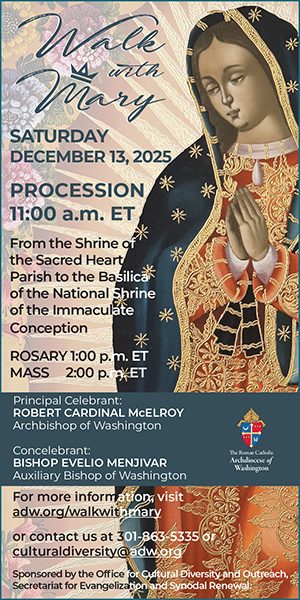World Youth Day pilgrims from a variety of dioceses in the United States spent Jan 21 admiring God’s creation in the Gamboa Rainforest, located just outside of Panama City. The rainforest’s watershed provides water that is necessary for the Panama Canal to continue running, providing essential revenue for the economy of Panama.
For Archdiocese of Washington pilgrims, the day began with a boat ride, which traveled through a portion of the Panama Canal. About 40 boats travel through the canal every day, waiting for their precise time slot to begin the 8-hour journey that allows travel between the Atlantic and Pacific Oceans.

The boat stopped at what the tour guides called “monkey island,” where they pilgrims saw several species of monkeys, including the Howler monkey, which is the loudest monkey in the rainforest, the Geoffrey’s tamarin monkey, which is the smallest monkey in Panama, and the white faced Capuchin monkey, which was named after Capuchin monks.

As the pilgrims made their way to the island, they got wet from the rain falling in the rainforest, which is actually rare for the dry season in Panama, which runs between January and April.

Afterward, the group visited a sloth sanctuary where representatives from the Pan American Conservation Association taught them about the process of rescuing endangered animals from the rainforest. When they arrived, one of the organization's representatives reminded them that although people sometimes complain about the rain, “without rain there is no life.”

Since the organization began 14 years ago, the Pan American Conservation Association has rescued 5,000 animals. The pilgrims had an opportunity to meet two of those animals – sloths named Casper and Sebastian.

Sloths can sleep 18 hours per day, which they use as a defense mechanism to help them blend and disappear in their rainforest environment. Now, because of construction, roads, shopping malls, and other development, the sloths are endangered.

Princess Nwadije, a 16-year-old parishioner of St. Matthias the Apostle Church in Lanham, said seeing all of the plants and animals in the rainforest reminded her that "everything [God] makes is beautiful."

After learning about animal rescue, the pilgrims walked through a butterfly garden, orchid nursery and frog exhibit.

The pilgrims then took an aerial tram that traveled 600 meters through the rainforest, putting the pilgrims at the level of the treetops, making the leaves and animals more visible than they would be from the ground.


The mountain they ascended was previously named “naked hill,” because all of the trees were cut down while the canal was being built. After people learned more about the importance of the rainforest to the ecosystems in Panama, they allowed the trees to grow back, and they have reached full maturity in just a few decades.
Leah Dantin, a 17 year-old pilgrim from the Diocese of St. Augustine, Florida, said this regrowth reminded her of humans' relationship with God, because “if we turn our back on God, he will always be there. We can always turn back to Him and regrow our faith.”

When the pilgrims reached the top of the mountain, they climbed a roughly 90-foot tall observation tower that gave them a panoramic view of the Chagres River, Gatun Lake and the Panama Canal.

Gatun Lake was man-made during the construction of the Panama Canal, when the canal’s builders flooded the valley of the Chagres River to store water, allowing the canal to continue operation through the dry season. Christopher Columbus explored the Chagres River in 1502, and learned from locals that there was another ocean just a few days' journey away. This led to the establishment of the Camino de Cruces, a route that allowed people to make a week-long journey, transporting shipments between oceans both by foot and by boat.

Joshua Saxton, a 17 year-old pilgrim who attends St. Joseph Catholic Church in Alexandria, Virginia, said he learned a lot about nature during the day, and was reflecting on how "we are all God's creation."
"When I see a tree, a flower, or a bush, I'm kind of like that," he said. "[God] made us all."













